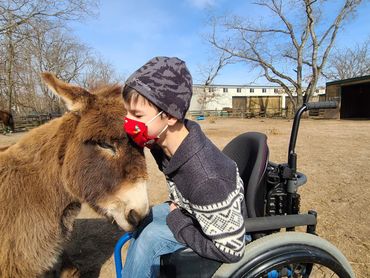(631) 479-3393 ex.3
(631) 479-3393 ex.3
Animal Assisted Therapy and Nature Based Therapy

Why incorporate animals and nature into therapy?
The planned inclusion of an animals and nature in a patient’s treatment session can be used to:
- Increase client motivation and participation in treatment.
- Provide an engaging and meaningful way to target the 5 main areas that SLPs treat (speech, language, social communication, cognitive-communication and swallowing).
Animals available to help in our sessions include horses, miniature horses, miniature donkeys, rabbits, sheep, and chickens. Our facility is situated on a beautiful 13 acre farm with beautiful outdoor treatment spaces.
We are pleased to offer this approach at our Islandia NY location.

Research related to animal assisted therapy
According to the Human Animal Bond Research Institute, "people are happier and healthier in the presence of animals. Scientifically-documented benefits of the human-animal bond include decreased blood pressure, reduced anxiety, and enhanced feelings of well-being." In addition, research provides evidence of the following benefits:
- Increased motivation
- Increased participation in treatment
- Increased social awareness
- Increased social skills and behaviors
- Increased independence
- Decreased feelings of isolation
- Decreased stress
- Improved socio-emotional functioning
- Increased display of social behaviors including talking, making physical contact and looking at faces
- Improved positive social behaviors including becoming more receptive to social advances from peers
- Increased oxytocin levels in the brain
- Changes in the levels of cortisol, epinephrine and norepinephrine

Animal Assisted Therapy Facts/Myths:
- The inclusion of animals in speech, language or feeding therapy is not the same as "Animal Assisted Activities" or "pet therapy". To learn more about the terminology related to animals in therapy visit Pet Partners.
- Animal assisted speech/language/feeding therapy is not a separate type of therapy or service. Because it is not a separate service, but rather a tool or approach used during a therapy session it is not appropriate to bill for it as a separate service.
- Prescriptions should be written for speech/language/feeding therapy regardless of the treatment tools and approaches that will be used. The treatment approaches will be selected by the therapist and may be changed at any time in order to most effectively treat the patient.





Speech Language Pathology in Motion, PLLC
829 Old Nichols Road, Islandia NY, United States
Phone: (631) 479-3393 Fax: (631) 479-3358
